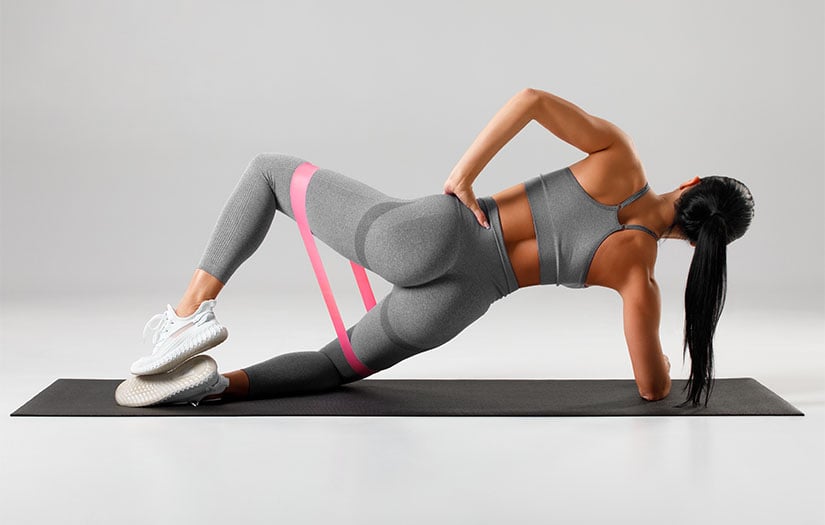If you haven’t heard of the banded clamshell exercise, it may just become a regular in your warm-up routine once you try it. This simple exercise will help to fire up your glutes so that you’re ready for a run, a lifting session, or to move better during your day with less pain.
Here, we break down this simple exercise and how it can help you stay warm, stay loose, and prep for a solid workout.
Overview of Banded Clamshell Exercise
Banded clamshells are great to use as part of a corrective exercise protocol, an extended warm-up, or when used as a core exercise. While clamshells are not as flashy as big moves like squats and lunges, they are an effective way to fire up the glutes.
Specifically, banded clamshells target the gluteus medius (glute med for short). The glute med is responsible for stabilizing the hip joint and controlling hip abduction and external rotation. If the glute med isn’t strong enough to do its job, it will recruit other muscles to come in and help, which can cause unnecessary pain and poor movement mechanics. Clamshells can help correct this issue by strengthening the glute med.
Clamshells gets their name from the way that the move resembles a clamshell opening and closing. To perform this move, you lay on your side with your knees bent, and you lift the top knee up as far as you can without rotating the hips back, and then return to the starting position. Banded clamshells simply add resistance by placing a band just above the knee for the duration of the exercise.
This move is easy to do, requires minimal equipment and space, and can be done virtually anywhere!
How to Do It (in steps)
Banded clamshell:
1. Find a comfortable and firm space to perform the exercise and place a resistance band just above the knee. You can try it without resistance first if you’d like!
2. Lay on one side, resting your head on your bottom arm so that your neck is in a neutral position. Your top hand can rest on the ground to stabilize you.
3. Bend your knees to 90 degrees, making sure your knees are stacked right on top of one another evenly. Your hips should be stacked on top of one another (not leaning back or forward). Good alignment is key in making sure you work the right muscles!
4. Keep your abs tight and slowly lift the top knee up as high as you can without rotating your hips back. Keep your feet together for the whole movement. You might also find it helpful to press your bottom heel into the ground to make sure those feet stay planted.
5. Slowly lower your top knee down to return to the starting position.
Do 10 to 15 reps and then switch sides. Perform this move for 1-3 sets, 2-4 times a week.
Once you’ve mastered the basic clamshell and the banded clamshell, you can try some progressions to make this move harder:
Progression 1: Add more resistance by using a heavier resistance band.
Progression 2: Side plank clamshell (master this move without band first, then add a resistance band to increase the difficulty).
1. Lay on your side on the mat in the same setup position as the clamshell, except your bottom elbow will be underneath your shoulder.
2. Pop up into a side plank, with the hips pressed forward so that your shoulder, hips, and knees are in a straight line.
3. Lift the top knee slowly to perform the clamshell movement, and slowly lower it back down to the starting position.
Do 10 to 15 reps and then switch sides. Perform this move for 1-3 sets, 2-4 times a week.
Banded clamshells and all progressions have the greatest benefit when used as part of a corrective protocol. If the glute med is weak or underactive, there is likely a muscle group that is overactive (like the hip flexors). To fully benefit from clamshells, follow a corrective protocol that:
1. Inhibits the overactive muscles with foam rolling.
2. Stretches the overactive muscles.
3. Activates the underactive muscles (this is where clamshells come in!)
4. Integrates the underactive muscle group (in this case the glute med) with a multi-joint exercise like banded glute bridging or banded squats.
Benefits of the Exercise
Increase hip stability. When you’ve been standing for a long period of time, you might find yourself sinking into one hip to get comfortable. The glute med is the muscle that helps prevent that move from happening when you perform normal activities like walking or standing. If your glute med is weak, your hips may not stay in a neutral position, causing unnecessary pain in the low back, and poor movement mechanics. Performing clamshells can ensure that your hips are stabilized!
Injury prevention. A weakened glute med can lead to injury in the knees or in the low back due to faulty movement patterns. Performing clamshells can reduce the risk of injury as the glute med is strengthened.
Decrease knee and low back pain. Some of the most common movement compensations, like knees caving in during squats, result from weakened glute med muscles. As a result of faulty movement mechanics over time, sometimes knee and low back pain can be the result. Stretching the overactive muscles and strengthening the glute med can help to reduce or eliminate pain that stems from this issue.
Improve running and exercise mechanics. Because clamshells help improve hip stability, runners and exercisers will be able to move with better form, better efficiency (not wasting excess energy), and less pain – win! Performing clamshells as part of your warm-up will activate the glute med so that it’s ready to function properly.
Who This Can Benefit
Because most people spend most of their day seated, this is an exercise that we could ALL benefit from! Additionally, strengthening the glute med can really help runners and lifters improve their form and reduce their risk of injury.
Summary
Banded clamshells are a simple exercise that will strengthen the glute med to improve your overall movement, hip alignment, and it may also help to reduce low back and knee pain caused by glute med weakness. Give this move a try and mix it into your routine today.

















